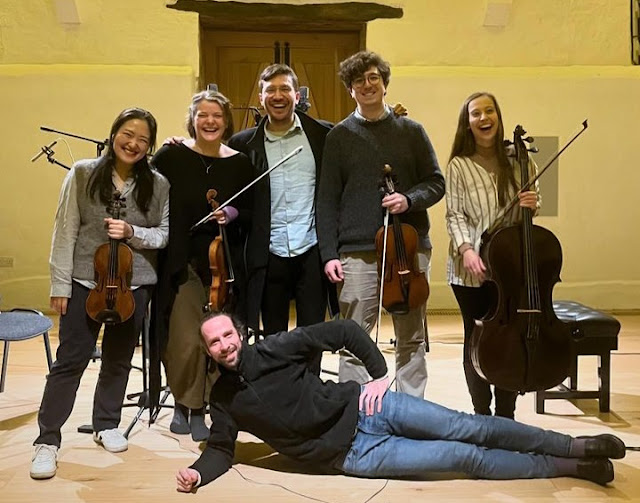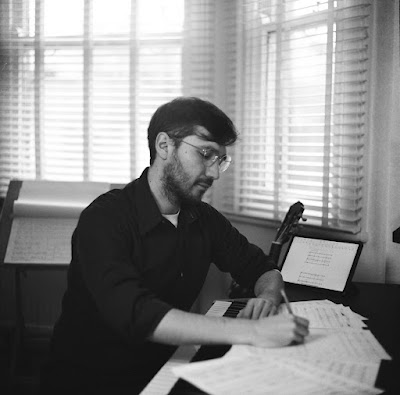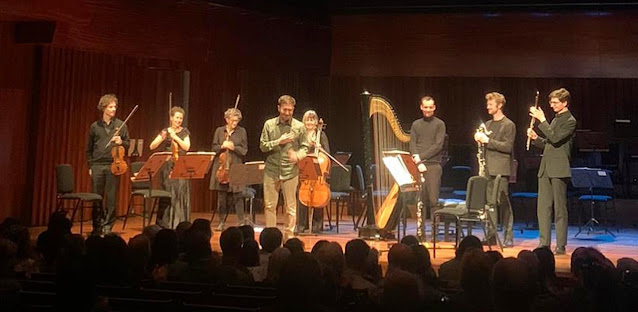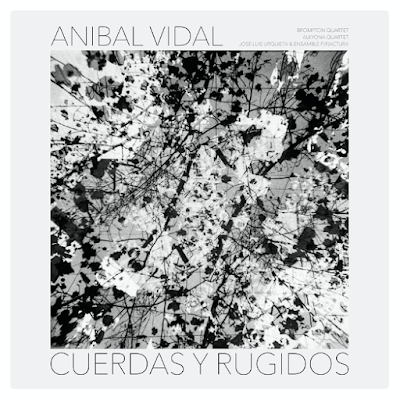 |
| The Brompton Quartet, Aníbal Vidal & Ignacio LusardiMonteverde at recording session for Cuerdas y Rugidos |
Chilean composer Aníbal Vidal released his album, Cuerdas y Rugidos (Strings and Roars), on the Sello Modular label last month. Aníbal is currently on the Britten Sinfonia‘s Magnum Opus scheme, they premiered a work by him at Milton Court in April and will be premiering another of his works in the Autumn.
 |
| Aníbal Vidal |
The new disc features three of Aníbal’s chamber works, Camanchaca – String Quartet No.1 performed by the Brompton Quartet, Unboxing a Music Box – String Quartet No.2 performed by the Alkyona Quartet and Three Chants for assembling an Oboe for oboe and string quartet performed by José Luis Urquieta and ensemble f(r)actura. Aníbal has been writing chamber music for the past three years, he finds you have a more developed exchange with the performer, whereas with orchestral music there is not such a close collaboration. So, exploring a soundscape or musical landscape is far more exciting with a chamber group, though he admits that the recording also makes economic sense.
Camanchaca, his String Quartet No.1, is based on an idea he has had for years. Chile is a seismic country, most people have experienced at least three earthquakes. He has a distinct sound memory of earthquakes, how the houses sound when shaking, and the roars beneath the ground. He experienced the tsunami of 2010 when he was living in a small coastal village and all the fishermen’s boats smashed against the breakwater creating a truly memorable sound that he likened to a Titan playing with the boats. In Camanchaca he imagines a peaceful landscape alongside the sound memories of the earthquakes.
Also on the disc is Three Chants for assembling an Oboe which uses his own specific notation, though he emphasises that the notation is a means to an end. [Read more about his notation in an interview he gave with The Strad]. He talks about the playfulness involved in the act of composing, with a serious emphasis to play as the composer becomes immersed in their own world, whether it be dramatic, romantic or whatever. He likes close contact with the instruments that he is writing for and though he does not play the oboe, he bought an oboe reed to experiment with; he also has a clarinet and started using the body to make sounds. His first thought, when writing for oboe and string quartet, was the oboe and the strings do not match in the colours they make. For the piece, he deconstructs the oboe (hence the work’s title), The first movement uses just the body of the instrument, the second movement just the reed and only in the third movement is the oboe fully assembled. Thus, he feels, he has altered the relationship between the strings and the oboe. And, of course, he had to develop his own notation because what he was writing went beyond traditional notation.
He does not feel that his music is distinctively Chilean. Whilst he does take inspiration from the country, he does not use folk music and he is influenced in a broader sense by the way of living in South America, what he calls the way of coping with reality. He finds this very attractive, and he refers to the cultural myths and legends that forged his identity. But his music is not specifically Chilean or even South American, though some influence comes through.
Other inspirations include classical composers like Ligeti, Stravinsky and Mahler, plus a range of contemporary composers including Thomas Adès and Bernhard Lang. In fact, he trained as a jazz guitarist and has a parallel career in film music. [See his showreel on YouTube.] For his film music, he uses samples of a large range of small percussion instruments to expand the sound palate. He emphasises that film music has another end, dramatic or commercial, and does not just depend on the music itself. He finds it a challenge, there is his inspiration but it is filtered through the external requirements. Whilst he considers his film music and concert music as separate, his interest in using the sampled small percussion instruments in film music led to his interest in the way the instruments were used and led him towards the way he writes for instruments in his concert music.
 |
| Aníbal Vidal & Britten Sinfonia at Milton Court after premiere of Invocación n.1: a mi arcano el Ermitaño |
In the Autumn, Britten Sinfonia will be premiering the second of his pieces as part of the Magnum Opus scheme. This will be a fifteen-minute trumpet concertino, and when we spoke, he had only recently had his first meeting with the soloist. He is keen to learn more about the instrument and find his way around it, so he has recently bought a second-hand trumpet. His first collaboration with Britten Sinfonia, premiered in April 2024, was a septet (flute, bass clarinet, harp, string quartet), Invocación n.1: a mi arcano el Ermitaño, with the trumpet concertino being Invocación n.2. He describes the septet as an exploration of evoking the human voice through instruments. This continues with the trumpet concertino where he explores writing for the trumpet and invoking the human voice, along with responses from the orchestra.
He describes the Magnum Opus scheme as very helpful and very holistic, it is not just about writing the music but about what happens behind the scenes, so that the day after we speak he was spending time at the Britten Sinfonia office learning about the administration involved. He feels that the Magnum Opus composers are incorporated into the grand scheme of Britten Sinfonia, understanding how decisions are made and learning to interact with performers. Also, the scheme provides the chance to write two works for the orchestra.
Looking ahead, he has a commission from the Carice Singers for the 2025 Spitalfields Festival which will be an oratorio for narrator and vocal ensemble. It is to be a large-scale work and he is currently working with the librettist on a text that explores pagan myths of creation. He is fascinated by the way similar creation myths crop up in different cultures so that the native people from Chile have a similar myth to the ancient Sumerian empire. The work will be a theatrical depiction of pagan creation for voices alone, though each singer will have a smaller instrument to play too, and each will take part in the narration.
His film music has included two independent feature films, and some TV series, most recently Cromosoma 21, a Netflix Latin American series. His film music incorporates a lot of synthesisers and he admits to enjoying working with ‘gear’, what he calls the sound-designer side of composition.
So far, his concert music has only included one work involving electronics, as he has tended to keep the electronics side for film music. But next year, he will be writing an orchestral piece which will use electronics, recorded samples triggered from a keyboard, alongside the regular orchestra. It will be his first attempt at mixing the two in his concert music.
When he was learning the guitar, he created his own music and was always interested in writing songs, finding he had a deep curiosity and need to express something, an energy inside him that needed to be put out. He started writing when he was 12, and this became stronger than his need to perform. He doesn’t ask why, it’s just what he does. For Aníbal, writing music is a way to find out who he is, to confess something, and to clarify himself, so composition is a process of resolving something. He calls it an intuitive abstract Sudoku working with sound parameters and with no single solution.
Never miss out on future posts by following us
The blog is free, but I’d be delighted if you were to show your appreciation by buying me a coffee.
Elsewhere on this blog
- Youth, experience and a warm reception: our visit to the Glasperlenspiel Festival in Tartu, Estonia – concert review
- Sustainable Opera for the Future by Max Parfitt of Wild Arts – guest article
- As vivid and vigorous as ever: David McVicar’s production of Handel’s Giulio Cesare returns to Glyndebourne with a terrific young cast – opera review
- Expressionism and rigour: soprano Claire Booth on recording Pierrot Lunaire and the importance of exploring Schoenberg’s songs – interview
- Something of a minor revelation: choral music by Giovanni Bononcini who was brought to England as Handel’s operatic rival – record review
- Pierrot Lunaire, Curlew River and a visit from the Hallé Orchestra: closing weekend of the 75th Aldeburgh Festival – concert review
- Youthfully engaging: a visually stylish new Rake’s Progress at the Grange Festival made us really care for about these characters – opera review
- A richly layered depiction of characters in all their fallibility: Monteverdi’s L’incoronazione di Poppea at the Grange Festival – opera review
- The Sea and Ships: the London Song Festival celebrates the first Shipping Forecast to be broadcast on British radio – concert review
- Much more than a piece of history: Roderick Cox conducts Shostakovich’s Symphony No. 10 at the Royal Academy of Music – concert review
- Home










